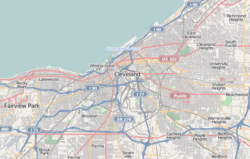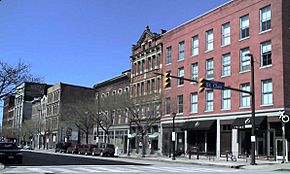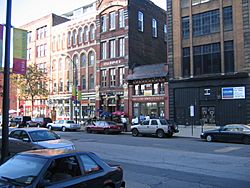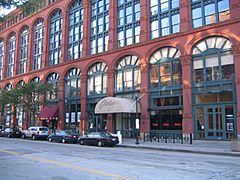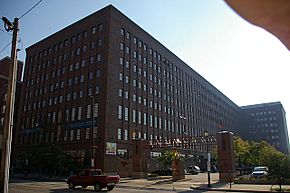Warehouse District, Cleveland facts for kids
|
Cleveland Warehouse District
|
|
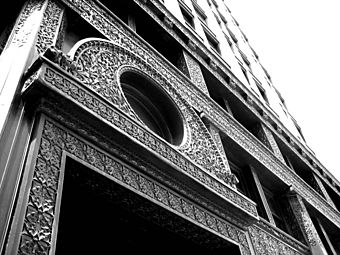
The decorative iron facade of the Rockefeller Building (Cleveland) on Superior Avenue
|
|
| Location | Cleveland, Ohio |
|---|---|
| Built | 1850 |
| Architectural style | Early Commercial, Italianate |
| NRHP reference No. | 82003558 (original) 07000070 (increase) |
Quick facts for kids Significant dates |
|
| Added to NRHP | September 30, 1982 |
| Boundary increase | February 21, 2007 |
The Warehouse District is a special historic area in downtown Cleveland, Ohio. It is known for its old buildings. This district is found between Front Avenue, Superior Avenue, West 3rd Street, and West 10th Street.
This area was added to the National Register of Historic Places on September 30, 1982. It was named the Cleveland Warehouse District. Later, on February 21, 2007, its boundaries were made a bit larger.
Contents
History of the Warehouse District
In the early 1800s, this neighborhood was a place where people lived. It was one of Cleveland's first residential areas. Later in the 1800s, it became a busy center for businesses.
Many buildings here were used as warehouses. They stored and moved goods for over 100 years. Over time, the way goods were moved changed. The warehouses became empty and run-down.
The area still has tall buildings that show Cleveland's industrial past. A famous one is the Rockefeller Building (Cleveland). In the late 1980s, the Warehouse District started to change. It became a popular place for young adults to go out.
How the District Changed
The Warehouse District began to transform in the late 1980s. A comedy club called Hilarities opened there first. At first, the district tried to attract artists. They wanted artists to live and work in the old buildings.
But the rent became too high. The area also became very popular. This made it hard for artists to stay. Many artists moved to other Cleveland neighborhoods. These included Tremont or St. Clair Superior.
Artists and Early Changes
Some artists were among the first to move into the Warehouse District. Steven B. Smith and S. Judson Wilcox moved there in 1981. They were like "urban pioneers." Artists, musicians, and creative people liked the industrial look of Cleveland.
Smith's warehouse space became a meeting place for other artists. They would gather there and share their work. Spaces Gallery was also located on the first floor. This made the warehouse a center for creative activities.
Artists often move to places that are cheap. They fix up old buildings to live and work. Then, as areas become popular, they move again. In the 1980s, many artists moved from the Warehouse District to Tremont.
Modern Life in the District
By the year 2000, many of the old buildings were restored. They became home to many restaurants and clubs. West Sixth Street is a very lively part of the district. It has many places to eat and hang out.
Many old warehouses have also been turned into offices and homes. The beautiful old fronts of these buildings are kept. But the inside of the buildings are made new and modern.
These new apartments and condominiums have helped Cleveland's downtown population grow. Most of the remaining old buildings have been fixed up. Builders are also planning new buildings in the empty spaces.
Images for kids


